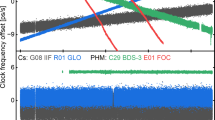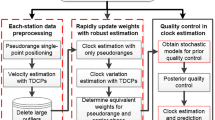Abstract
During the past years, real-time precise point positioning has been proven to be an efficient tool in the applications of navigation, precise orbit determination of LEO as well as earthquake and tsunami early warning, etc. One of the most crucial issues of these applications is the high-precision real-time GNSS satellite clock. Though the performance and character of the GNSS onboard atomic frequency standard have been widely studied, the white noise model is still the most popular hypothesis that employed in the real-time GNSS satellite clock estimation. However, concerning the real-time applications, significant data discontinuity may arise either due to the fact that only regional stations involved, or the failure in the stations, satellites and network connections. These data discontinuity would result in an arbitrary clock jump between adjacent arcs when the clock offsets are modeled as white noise. In addition, it is also expected that the detection and identification of outliers would be benefited from the constrains of the satellite oscillator noise model. Thus in this contribution, based on the statistic analysis of almost 2-year multi-GNSS precise clock products, we developed the oscillator noise model for the satellites of GPS, GLONASS, BDS and Galileo according to the oscillator type as well as the block type. Then, the efficiency of this oscillator noise model in multi-GNSS satellite clock estimation is demonstrated with 2-months data for both regional and global networks in simultaneous real-time mode. For the regional network, the results suggest that compared with the traditional solution based on white noise model, the improvement is 44.4 and 12.1% on average for STD and RMS, respectively, and the improvement is mainly attributed to the efficiency of the oscillator noise model during the convergence period and the gross error resistance. Concerning the global experiment, since the stations guarantee the continuous tracking of the satellites with redundant observable, the improvement is not as evident as that of regional experiment for GPS, GLONASS and BDS. The STD of Galileo clock improves from 0.28 to 0.19 ns due to that, the satellites E14 and E18 still suffer significant data discontinuity during our experimental period.














Similar content being viewed by others
References
Allan DW (1987) Time and frequency (time-domain) characterization, estimation, and prediction of precision clocks and oscillators. IEEE Trans Ultrason 34(6):647–654. https://doi.org/10.1109/t-uffc.1987.26997
Bisnath S, Gao Y (2008) Current state of precise point positioning and future prospects and limitations. In: Sideris MG (ed) Observing our changing earth, vol 133. Springer, Berlin, pp 615–623. https://doi.org/10.1007/978-3-540-85426-5_71
Blaha G (1982) Free networks: minimum norm solution as obtained by the inner adjustment constraint method. Bull Géodésique 56(3):209–219. https://doi.org/10.1007/BF02525582
Bock H, Dach R, Jaeggi A, Beutler G (2009a) High-rate GPS clock corrections from CODE: support of 1 Hz applications. J Geod 83(11):1083–1094. https://doi.org/10.1007/s00190-009-0326-1
Bock H, Dach R, Yoon Y, Montenbruck O (2009b) GPS clock correction estimation for near real-time orbit determination applications. Aerosp Sci Technol 13(7):415–422. https://doi.org/10.1016/j.ast.2009.08.003
Cressie N (1993) Statistics for spatial data. Wiley, Amsterdam, p 928
Cressie N, Hawkins DM (1980) Robust estimation of the variogram: I. Math Geol 12(2):115–125. https://doi.org/10.1007/BF01035243
Ge M, Chen J, Douša J, Gendt G, Wickert J (2011) A computationally efficient approach for estimating high-rate satellite clock corrections in realtime. GPS Solut 16(1):9–17. https://doi.org/10.1007/s10291-011-0206-z
Gong X, Gu S, Lou Y, Zheng F, Ge M, Liu J (2017) An efficient solution of real-time data processing for multi-GNSS network. J Geod 16:1–13. https://doi.org/10.1007/s00190-017-1095-x
Gu S, Shi C, Lou Y, Feng Y, Ge M (2013) Generalized-positioning for mixed-frequency of mixed-GNSS and its preliminary applications. In: Proceedings on China satellite navigation conference (CSNC), pp 399–428. https://doi.org/10.1007/978-3-642-37404-3_35
Hauschild A (2010) Precise GNSS clock-estimation for real-time navigation and precise point positioning. Technical University of Munich, Munich
Hauschild A, Montenbruck O (2009) Kalman-filter-based GPS clock estimation for near real-time positioning. GPS Solut 13(3):173–182. https://doi.org/10.1007/s10291-008-0110-3
Huang GW, Zhang Q (2012) Real-time estimation of satellite clock offset using adaptively robust Kalman filter with classified adaptive factors. GPS Solut 16(4):531–539. https://doi.org/10.1007/s10291-012-0254-z
Huang GW, Zhang Q, Li H, Fu W (2013a) Quality variation of GPS satellite clocks on-orbit using IGS clock products. Adv Space Res 51(6):978–987. https://doi.org/10.1016/j.asr.2012.09.041
Huang GW, Zhang Q, Xu GC (2013b) Real-time clock offset prediction with an improved model. GPS Solut 18(1):95–104. https://doi.org/10.1007/s10291-013-0313-0
Hutsell CST (1995) Relating the Hadamard variance to MCS Kalman filter clock estimation. In: Proceedings of the 27th annual precise time and time interval systems and applications meeting, San Diego, California, Nov 1995, pp 291–302
Kouba J, Héroux P (2001) Precise point positioning using IGS orbit and clock products. GPS Solut 5(2):12–28
Laurichesse D, Cerri L, Berthias JP, Mercier F (2013) Real time precise GPS constellation and clocks estimation by means of a Kalman filter. Presented at the 26th international technical meeting of the Satellite Division of the Institute of Navigation, ION GNSS 2013
Lindsey W (1976) Theory of oscillator instability based upon structure functions. Proc IEEE 64(12):1652–1666. https://doi.org/10.1109/PROC.1976.10408
Liu Y, Ye S, Song W, Lou Y, Gu S (2017) Rapid PPP ambiguity resolution using GPS+ GLONASS observations. J Geod 91:441–455. https://doi.org/10.1007/s00190-016-0975-9
Lou Y, Zheng F, Gu S, Wang C, Guo H, Feng Y (2015) Multi-GNSS precise point positioning with raw single-frequency and dual-frequency measurement models. GPS Solut 20(4):849–862. https://doi.org/10.1007/s10291-015-0495-8
Männel B (2017) Reprocessing the elliptical orbiting Galileo satellites E14 and E18: preliminary results. Presented at the EGU General Assembly 2017
Montenbruck O, Hauschild A, Steigenberger P, Hugentobler U, Teunissen PJG, Nakamura S (2012) Initial assessment of the COMPASS/BeiDou-2 regional navigation satellite system. GPS Solut 17(2):211–222. https://doi.org/10.1007/s10291-012-0272-x
Petit G, Thomas C (1996) GPS frequency transfer using carrier phase measurements. Presented at the 1996 IEEE international frequency control symposium. IEEE, pp 1151–1158. https://doi.org/10.1109/FREQ.1996.560307
Senior KL, Ray JR, Beard RL (2008) Characterization of periodic variations in the GPS satellite clocks. GPS Solut 12(3):211–225. https://doi.org/10.1007/s10291-008-0089-9
Shi C, Gu S, Lou Y, Ge M (2012) An improved approach to model ionospheric delays for single-frequency precise point positioning. Adv Space Res 49(12):1698–1708. https://doi.org/10.1016/j.asr.2012.03.016
Shi C, Lou Y, Song W, Gu S, Geng C, Yi W, Liu Y (2013) A wide area real-time differential GPS prototype system in China and result analysis. Surv Rev 43(322):351–360. https://doi.org/10.1179/003962611X13055561708623
Shi C, Zheng F, Lou Y, Gu S, Zhang W, Dai X, Li X, Guo H, Gong X (2017) National BDS Augmentation Service System (NBASS) of China: progress and assessment. Remote Sens 9(8):837. https://doi.org/10.3390/rs9080837
Shmaliy YS, Marienko AV, Savchuk AV (1999) GPS-based optimal Kalman estimation of time error, frequency offset, and aging. Presented at the 31st annual precise time and time interval meeting, 1999, pp. 431–440
Steigenberger P, Hugentobler U, Hauschild A, Montenbruck O (2013) Orbit and clock analysis of Compass GEO and IGSO satellites. J Geod 87(6):515–525. https://doi.org/10.1007/s00190-013-0625-4
Stein SR (1989) Kalman filter analysis of precision clocks with real-time parameter estimation. In: Proceedings of the 43rd annual symposium on frequency control, 1989, pp 232–236
Swift ER, Hermann BR (1988) Orbit period frequency variations in the GPS satellite clocks. In: Proceedings of the 20th annual precise time and time interval (PTTI) applications and planning meeting, Vienna, VA (USA), Nov 29–Dec 1, pp 87–100
Wang B, Lou Y, Liu J, Zhao Q, Su X (2017) Analysis of BDS satellite clocks in orbit. GPS Solut 20(4):783–794. https://doi.org/10.1007/s10291-015-0488-7
Weber G, Mervart L, Lukes Z, Rocken C, Dousa J (2007) Real-time clock and orbit corrections for improved point positioning via NTRIP. In: Proceedings of ION-GNSS-2007
Wright JR (2007) GPS composite clock analysis. Presented at the frequency control symposium, 2007 Joint with the 21st European frequency and time forum. IEEE International, pp 523–528. https://doi.org/10.1109/FREQ.2007.4319128
Wübbena G (1988) GPS carrier phases and clock modeling. In: Groten E, Strauß R (eds) GPS-techniques applied to geodesy and surveying, vol 19. Springer, Berlin, pp 381–392. https://doi.org/10.1007/BFb0011350
Zhang W, Lou Y, Gu S, Shi C, Haase JS, Liu J (2015) Joint estimation of GPS/BDS real-time clocks and initial results. GPS Solut 20(4):665–676. https://doi.org/10.1007/s10291-015-0476-y
Zumberge JF, Heflin MB, Jefferson DC, Watkins M, Webb FH (1997) Precise point positioning for the efficient and robust analysis of GPS data from large networks. J Geophys Res 102(B3):5005–5017
Acknowledgements
This study is sponsored by the National Key Research and Development Plan (No. 2016YFB0501802). The authors thank the anonymous reviewers for their valuable comments. Thanks also go to IGS for data provision.
Author information
Authors and Affiliations
Corresponding author
Rights and permissions
About this article
Cite this article
Shi, C., Guo, S., Gu, S. et al. Multi-GNSS satellite clock estimation constrained with oscillator noise model in the existence of data discontinuity. J Geod 93, 515–528 (2019). https://doi.org/10.1007/s00190-018-1178-3
Received:
Accepted:
Published:
Issue Date:
DOI: https://doi.org/10.1007/s00190-018-1178-3




